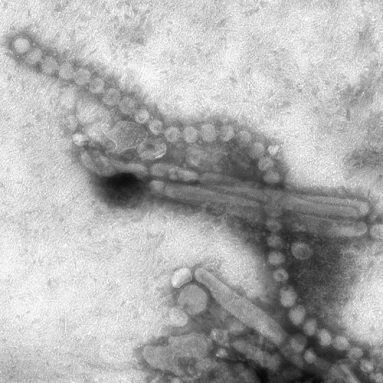Deadly new flu
The germ responsible carries genes from other flu viruses

Centers for Disease Control and Prevention, National Center for Immunization and Respiratory Diseases (NCIRD)
A new kind of influenza, or flu, that started in birds is now taking a toll on humans. In China, the disease has sickened more than 100 people; 22 have died. Some of those infected have suffered brain damage and organ failure. Others have had mild symptoms — or shown no symptoms at all. The disease has also been diagnosed in nearby Taiwan.
Scientists are racing to understand the new infection. When birds start dying from flu, researchers pay close attention. That’s because people may start to get sick, too, Ana Fernandez-Sesma told Science News. She studies how the body defends itself against viruses at New York’s Mount Sinai Hospital.
As in all types of flu, a virus causes the new one, which scientists refer to as H7N9. A virus is a microscopic germ with only one goal: infection. Viruses invade and kill healthy cells of some host, which may be a bird, a plant, a person or some other living thing. Inside its host, the virus copies itself. Each copy can then go on to attack more cells.
One reason this flu has been hard to study is that it may not make birds sick, reports Rongbao Gao of the Chinese Center for Disease Control and Prevention. So the virus may spread quickly through the bird population without people noticing.
Another challenge of studying the flu: Viruses change quickly. Each germ contains genetic information that acts like a codebook on how to invade and kill cells. But that information changes as viruses pick up elements from each other and morph into new viruses.
In April, researchers including Gao reported that the new flu virus contains genetic contributions from at least three previously known flu germs. Those viruses may have swapped information when they all infected the same bird. Or the new virus may have been cobbled together over several infections in different birds.
Different types of the H7N9 flu virus have been identified. The first man diagnosed with this flu lived in Shanghai. The virus isolated from him resembled the virus found in an infected pigeon. Two people who died from the new flu had been infected with a virus similar to one found in a chicken in a market in Shanghai. These connections are like clues for epidemiologists. These scientists are detectives who try to figure out where a disease starts and how it spreads.
In April, scientists from the World Health Organization reported finding the new flu virus in chickens and pigeons in some Chinese markets. But that same study turned up a mystery. Those viruses were different enough from the human types that scientists wonder if H7N9 changed while inside an animal other than birds, before infecting people.
The case soon became even more complicated. The Beijing Municipal Health Bureau in China’s capital city reported that a 4-year-old local boy has the virus — but he’s not sick.
Most people are probably vulnerable to the new flu. And scientists are concerned that some types of the germ responsible may spread from person to person through the air. That could really speed the spread of the disease.
But so far the virus can’t spread that way. Some families have more than one person sick with the virus, but it is not clear if they caught the flu from each other. And even if a few people have passed their flu to another person, that type of spread is limited. That’s because it is probably very difficult for a bird flu virus to develop the ability to jump from person to person, explains Fernandez-Sesma.
Power Words
flu, or influenza A highly contagious viral infection of the respiratory passages that causes fever, swelling and severe aching.
virus An infection-causing agent that typically has genetic material surrounded by a protein coat. A virus is too small to be seen with the naked eye and is able to multiply only within the living cells of a host organism. A virus can survive and multiply only in the living cells of a host, such as people.
infectious A germ that can be transmitted to people, animals or other living things
World Health Organization An agency of the United Nations, established in 1948, to promote health and to control communicable diseases.
zoonosis Any disease that originates in nonhuman animals that can be transferred to people.







